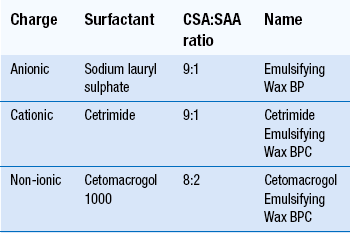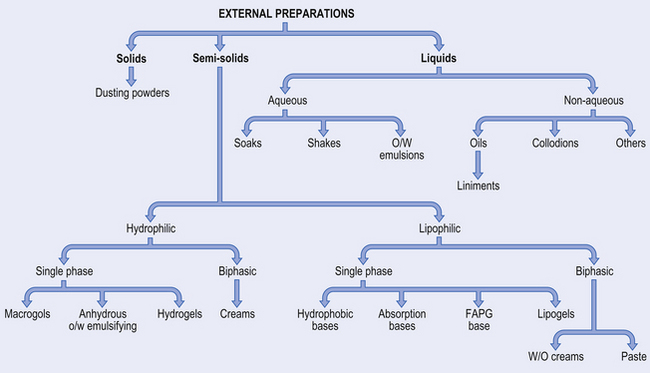36 Skin is the largest organ in the body and has three distinct regions. The hypodermis is the innermost and is often called subcutaneous fat. The dermis is the bulk of the thickness of the skin and contains blood vessels, nerve fibres, sweat glands and hair follicles. The outermost region is the epidermis, which is made up of several layers. One of these layers is the stratum basale, in which cells divide and as they move towards the surface, they change appearance and function. The outermost layer, the stratum corneum, acts as the skin barrier. It is made up of about 20 layers of dead keratinized cells. The hair follicles and sweat ducts pass through the stratum corneum to reach the surface. A simplified diagram showing the main skin structures is given in Figure 36.1. Figure 36.1 Diagrammatic representation of the skin showing the main structures, location of diseases and the sites of action of drugs. There are a large number of diseases which may affect different regions of the skin. Any drug used will need to reach the site of the disease in order to act. Unless it is for a surface effect only, the drug must either pass through the stratum corneum or go through hair follicles or sweat ducts. Examples of drugs applied to the skin and their sites of action are shown in Figure 36.1. Once in the skin, a lipid-soluble drug will tend to accumulate in lipid regions, while more water-soluble drugs will tend to enter the blood capillaries and be removed from the skin. There are also many metabolic enzymes in the skin which can deactivate drugs. There are an increasing number of drugs that are effective against skin diseases, but drugs are not the only way of treating skin conditions. Creating physiological changes in the skin can also be beneficial. The main change is to control the moisture content of the skin. Normal skin has 10–25% moisture in the stratum corneum. This level may be reduced in, for example, eczema, or increased, as in skin maceration between the toes. By using an occlusive product (that is, an oily product), water leaving the body through the skin will be trapped and the moisture content will increase. These products are called emollients. An excess of moisture may be removed using an astringent, a hygroscopic material or, to a lesser extent, a dusting powder. Where an oily vehicle is needed, but moisture must not increase, adding solid particles to the vehicle will allow water to escape. Lubrication of sensitive skin is achieved by using finely divided solids, applied either as a powder or, more efficiently, as a suspension. Cooling the skin relieves inflammation and eases discomfort. It is achieved by evaporating a solvent, usually water or a water and alcohol mixture. Volatile solvents sprayed on the skin give intense cooling. There are a large number of different types of external medicine, ranging from dry powders through semi-solids to liquids. The names are often traditional making classification difficult. Figure 36.2 illustrates the formulation of the main types of preparation used on the skin. Lotions are aqueous solutions, suspensions (see Example 36.1) or emulsions that cool inflamed skin and deposit a protective layer of solid. Liniments are alcoholic or oily solutions or emulsions (see Example 36.2) designed to be rubbed into the skin. The medicament is usually a rubefacient. Applications are solutions or emulsions that frequently contain parasiticides (see Example 36.3). Paints and tinctures are concentrated aqueous or alcoholic antimicrobial solutions. Collodions are organic solvents containing a polymer and drug. There are also many other liquid products including shampoos and foot washes. Ointments are usually oily vehicles that may contain a surfactant to allow them to be washed off easily (barrier creams). They are used as emollients, or for drug delivery either to the surface or for deeper penetration. Pastes are vehicles (aqueous or oily) with a high concentration of added solid. This makes them thick so they do not spread and so localizes drug delivery (e.g. Dithranol in Lassar’s Paste, see Example 36.9). They can also be used for sun blocks. Oils used in external preparations come from one of three sources. Mineral oils (paraffins) are the most widely used. They are complex mixtures of mainly saturated hydrocarbons, which are available in different fractions. Different names are used in different pharmacopoeias (Table 36.1). Table 36.1 Paraffins used in external preparations: the names used are different in the UK, USA and European pharmacopoeias Light liquid paraffin is not normally used in external medicines. Soft paraffin is the main ingredient in many products, with liquid or hard paraffin being used to thin or thicken them respectively. There are two forms of soft paraffin: yellow and white. The latter has been bleached, residues of which may remain. As a general rule, white is used with white or pale coloured ingredients, while yellow is used for darker ingredients. The paraffins are occlusive and chemically inert, but do not give good skin penetration. Emulsifying waxes each contain two ingredients: cetostearyl alcohol and a surface-active agent, as shown in Table 36.2. All three bases are waxy solids that mix with oily materials. Addition of water produces an o/w emulsion – a cream. Both the non-aqueous blends and the creams are easily washed off the skin. Varying the amount of bodying agent, usually cetostearyl alcohol, can control consistency. The ratio of oil to water will also alter the consistency of a cream. Table 36.2 The ingredients used in the emulsifying waxes described in the British Pharmacopoeia (BP) and British Pharmaceutical Codex (BPC)
External preparations
 Skin structure and sites of action of drugs
Skin structure and sites of action of drugs
 The types and functions of solid, liquid and semi-solid skin preparations
The types and functions of solid, liquid and semi-solid skin preparations
 The ingredients used in skin preparations
The ingredients used in skin preparations
 Dispensing preparations for use on the skin
Dispensing preparations for use on the skin
Introduction

Types of skin preparation
Liquids
Semi-solids
Ingredients used in skin preparations
Oily vehicles
UK
USA
European
Light liquid paraffin
Light mineral oil
Paraffinium perliquidum
Liquid paraffin
Mineral oil
Paraffinium liquidum
Soft paraffin
Petrolatum
Paraffinium molle
Hard paraffin
Paraffin
Paraffinium durum
Emulsifying agents
Emulsifiers – o/w

![]()
Stay updated, free articles. Join our Telegram channel

Full access? Get Clinical Tree


External preparations
Only gold members can continue reading. Log In or Register to continue


